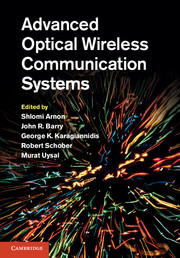Book contents
- Frontmatter
- Contents
- List of contributors
- Part I Outlook
- Part II Optical wireless communication theory
- 2 Coded modulation techniques for optical wireless channels
- 3 Wireless optical CDMA communication systems
- 4 Pointing error statistics
- 5 Equalization and Markov chains in cloud channel
- 6 Multiple-input multiple-output techniques for indoor optical wireless communications
- 7 Channel capacity
- Part III Unique channels
- Part IV Applications
- Index
7 - Channel capacity
from Part II - Optical wireless communication theory
Published online by Cambridge University Press: 05 June 2012
- Frontmatter
- Contents
- List of contributors
- Part I Outlook
- Part II Optical wireless communication theory
- 2 Coded modulation techniques for optical wireless channels
- 3 Wireless optical CDMA communication systems
- 4 Pointing error statistics
- 5 Equalization and Markov chains in cloud channel
- 6 Multiple-input multiple-output techniques for indoor optical wireless communications
- 7 Channel capacity
- Part III Unique channels
- Part IV Applications
- Index
Summary
Introduction and channel models
Optical communications take place at high frequencies at which it is sometimes difficult to modulate the phase and frequency of the transmitted signal. Instead, some optical systems modulate the intensity of the signal. Such systems are consequently fundamentally different from standard (e.g., mobile) wireless systems. For example, the channel input cannot be negative because it corresponds to the instantaneous light intensity. Also, since the light intensity, and thus the input, is proportional to the instantaneous optical power, the average-power constraints apply linearly to the input and not, as is usual in standard radio communications, to its square.
In this chapter we focus on communication systems that employ pulse amplitude modulation (PAM), which in the case of optical communication is called pulse intensity modulation. In such systems the transmitter modulates the information bits onto continuous-time pulses of duration T, and the receiver preprocesses the incoming continuous-time signal by integrating it over nonoverlapping intervals of length T. Such continuous-time systems can be modeled as discrete-time channels where the (discrete) time k input and output correspond to the integrals of the continuous-time transmitted and received signals (i.e., optical intensities) from kT to (k + 1)T. Note that for such discrete-time systems, the achieved data rate is not measured in bits (or nats) per second, but in bits (or nats) per channel use.
We discuss three different discrete-time, pulse intensity modulated, optical channel models: the discrete-time Poisson channel, the free-space optical intensity channel, and the optical intensity channel with input-dependent Gaussian noise.
Information
- Type
- Chapter
- Information
- Advanced Optical Wireless Communication Systems , pp. 146 - 174Publisher: Cambridge University PressPrint publication year: 2012
